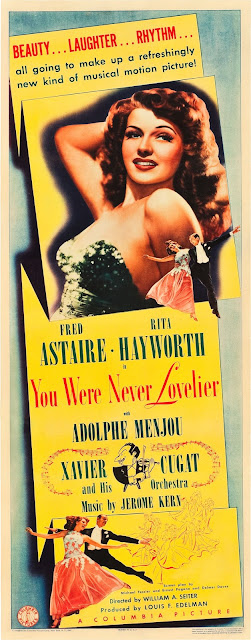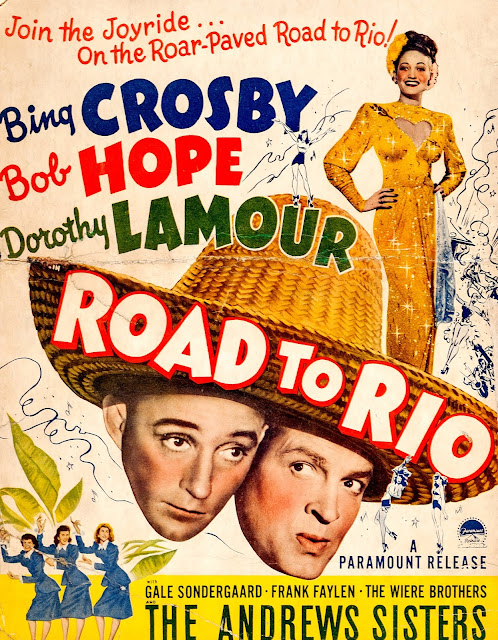A Love-Smitten Analyst Playing Dream Detective: Spellbound (1945)
SPELLBOUND is one of Hitchcock’s
underdogs. It deserves another look, so just dismiss anything you read about it
being silly in its take on psychoanalysis. As Hitch would say, “It’s only a
moo-vie.” It’s also a very enjoyable film, starring Ingrid Bergman and Gregory
Peck as one of the most beautiful couples on celluloid.
SPELLBOUND is about Dr. Constance
Petersen, a female psychiatrist at Green Manors. The head psychiatrist, Dr. Murchison
(played by the ever reliable Leo G. Carroll) has been forced to retire after a
short absence from nervous exhaustion, so a man named Dr. Anthony Edwardes is
taking his place. Edwardes arrives, but he’s pretty strange. Constance falls
for him instantly (because come on, it’s Greg Peck), but before the two can
live happily after, Edwardes reveals he’s really an amnesiac who vaguely
remembered Edwardes and so took his place.
With the help of Constance and her old mentor Dr. Brulov, Peck’s character figures out he’s John Ballantyne, a doctor who suffered mentally from WWII and went to Dr. Edwardes for help, accidentally witnessing the psychiatrist’s murder. John is arrested for the murder, but Constance finds out it was really Dr. Murchison, who wanted to stay as head of Green Manors. Murchison threatens to shoot Constance when she confronts him, but she successfully leaves to call the police while Murchison is left to shoot himself instead, thus allowing John and Constance to happily reunite.
With the help of Constance and her old mentor Dr. Brulov, Peck’s character figures out he’s John Ballantyne, a doctor who suffered mentally from WWII and went to Dr. Edwardes for help, accidentally witnessing the psychiatrist’s murder. John is arrested for the murder, but Constance finds out it was really Dr. Murchison, who wanted to stay as head of Green Manors. Murchison threatens to shoot Constance when she confronts him, but she successfully leaves to call the police while Murchison is left to shoot himself instead, thus allowing John and Constance to happily reunite.
Bergman plays Constance superbly,
and it’s a wonder how her character hasn’t been analyzed as the great feminist
she is. Her fellow psychiatrists are total misogynists, especially Dr. Fleurot,
who picks on her because she doesn’t fawn over him. Constance loves her work
and is constantly criticized for it by Fleurot. It’s because of her profession
that Constance is able to help John; she utilizes her profession to not only
solve the mystery of who John is, but she ends up solving the murder of Dr.
Edwardes, too.
Constance is smarter than
the men in the film. When John runs away from Green Manors, she tracks him down
to a hotel in New York and tricks the hotel detective into getting her John’s
room number by pretending she had a fight with her husband and now she wants to
apologize. The detective understands, he says—he “knows what it feels like to
have a wife come chasing after you to apologize.” The guy also has a
know-it-all attitude, even comparing himself to a psychoanalyst, which must
seem hilarious to Constance. I can practically hear the detective talking to
other hotel employees about the little woman he saved from a creep in the lobby
and helped reunite her with her husband.
Throughout the film, Constance
eludes and outsmarts detectives. Not only is there the one from the hotel, but
she and John run into the police a few times. They’re able to sneak by them
each time (until John’s arrested near the end, of course), and it’s never
through the quick thinking of John. Also, Constance solves the murder the
police should have—another example of police incompetence from Hitch.
Her biggest accomplishment, though, is that she cures John practically on her own. Sure, Dr. Brulov helps her some, but most of the time he encourages her to drop the whole thing, which definitely does not deter Constance. Dr. Brulov actually has one of the more interesting quotes in the film: “Women make the best psychoanalysts, until they fall in love. After that, they make the best patients.” Hi, Dr. Brulov, meet Dr. Constance Petersen. Being in love with John only motivates her more, which is apparent whenever he tries to distract her from analyzing him by going all lovey-dovey and she firmly stops him (it can’t be easy saying no to Gregory Peck and those cheekbones).
Her biggest accomplishment, though, is that she cures John practically on her own. Sure, Dr. Brulov helps her some, but most of the time he encourages her to drop the whole thing, which definitely does not deter Constance. Dr. Brulov actually has one of the more interesting quotes in the film: “Women make the best psychoanalysts, until they fall in love. After that, they make the best patients.” Hi, Dr. Brulov, meet Dr. Constance Petersen. Being in love with John only motivates her more, which is apparent whenever he tries to distract her from analyzing him by going all lovey-dovey and she firmly stops him (it can’t be easy saying no to Gregory Peck and those cheekbones).
Constance’s dominance is especially
obvious in her wardrobe. Most of the time she can be seen wearing a shirt with
a small bowtie at the neck, and the scene with the hotel detective finds her in
an outfit similar to a man’s with a hat, a blazer jacket with handkerchief in
pocket, and another bowtie-collared shirt. Constance actually mentions her
clothing in a scene on a train when she’s talking to John about their lives
once they figure out who he is: “I always loved feminine clothes, but never had
time to wear them. I’m going to after this. I’m going to wear exactly the
things that please me, and you. Even very funny hats. You know, the kind that
make you look drunk?” I wonder if Constance felt forced to wear the masculine
clothing in order to get on equal level with her male co-workers. I’ve had a
hard time finding whoever did the costuming for this film, but whoever it was
did a great job and I’m sure Hitch had some input about it.
By the way, I love how the
screenwriter Ben Hecht makes the men at the clinic look like complete idiots.
In one scene after everyone’s found out that Peck isn’t Dr. Edwardes, the psychiatrists
of Green Manors are all gathered in a sitting room chatting about the impostor.
Dr. Fleurot, that wonderful misogynist, tells Constance straight up that “a
woman like you could never be involved with anybody sane or insane.” No one,
not even the kind Dr. Murchison, sticks up for Constance, but she gets the last
laugh because we know and she knows that she’s very much in love, and with
someone who clearly reciprocates the feeling. It’s one of many moments when the
know-it-all male is wrong and has no clue about women. Much later, when
Constance confronts Dr. Murchison with the truth, he tells her “You’re an
excellent analyst, but a rather stupid woman.” Dude. She just solved a murder
no one else did. And she totally calls your bluff by walking straight out of
the room while you hold your gun on her.
The only other female really depicted
in the film is Rhonda Fleming’s character, who is a man-hating nymphomaniac
being treated at the clinic. One feels like it’s because of behavior like
Fleming’s character’s that gives Constance’s co-workers such a screwed-up view
on women. The doctors are able to give Constance validation as an analyst, but
not as a woman. Ironically, John does the opposite—he knows that Constance is a
real woman who loves him, but as stated before, whenever she tries to analyze
him, he gets defensive and questions her capability, sometimes even insulting
her. She doesn’t let it faze her, though, because she recognizes it as him
deflecting attention away from his problem.
John Ballantyne is an example of the
classic impotent man in Hitch’s work. His amnesia renders him helpless and
vulnerable; the only thing he seems totally capable of is opening Constance’s
eyes to love and loving her in return. Although we find out that he’s a doctor,
he never uses those skills, even choking before a surgery at the clinic and
ultimately fainting. You’ve got to hand it to Gregory Peck here—John is not a
macho hero by any standards, but Peck never makes you feel like John’s
vulnerability is wimpy or whiny. He’s confused and frustrated, understandably
so.
One of Peck’s scenes really stands
out to me. Constance and John are staying the night at Dr. Brulov’s, but while
Constance is asleep, John is restless. He gets up and decides to shave, only to
fall into a trance when he sees that the shaving cream on the brush creates parallel lines, something that was recurs through the film and causes John inexplicable anguish. With razor in hand, John goes downstairs. Dr.
Brulov is still awake and he sees how troubled John is, so he gets him a glass
of milk that’s secretly spiked with sleeping medicine. As John drinks the milk,
the camera switches to John’s perspective, looking inside the milk glass and
everything. The scene then fades out to white instead of the usual black.
According to TCM’s website, this effect was created like this: “The shot was
made by placing a giant glass pail in front of the camera and then pouring a
large amount of milk into a trough below.” I gotta be honest, I thought it was
way more complicated than that.
The scene did, however, remind me of the scene in SUSPICION when Cary Grant’s bringing a
glass of possibly poisoned milk to Joan Fontaine. Also, John’s phobia of
parallel lines is basically recreated 19 years later in MARNIE, when Tippi Hedren has a huge aversion to the color red.
Another interesting thing to notice is during John’s crazy dream sequence. His
figure is seen running down a pyramid in a desert area while something flies
above him—sounds like NORTH BY NORTHWEST,
no?
SPELLBOUND was Hitchcock’s second film
with producer David O. Selznick, the first being REBECCA. The two famously didn’t get along; two titans seldom ever
do. Selznick picked this project because he was deep in psychoanalysis himself
and found it interesting. He even hired his own psychoanalyst, May E. Romm, to
be the advisor for the film. Selznick’s involvement is usually the reason why many
seem to dismiss SPELLBOUND—it’s not
a "true" Hitchcock picture. I say that’s bogus. I’ve never had a serious problem
with the Selznick-Hitchcock movies, and I think they deserve more credit than
they’re given.
Finally, the last thing I’ll say is about the score.
Miklos Rozsa does a beautiful job, and his use of the theremin (that humming
sound) was a first for a film score. Rozsa won an Academy Award for the music,
although he said that Hitchcock didn’t like the score and thought it got in the
way of his direction. Sorry Hitch, I’ll have to respectfully disagree.
With love,
Michaela

















Comments
Post a Comment